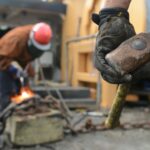Preventing Devastating Falls: Safeguarding Elderly Lives
As we age, the risk of falls increases, often leading to serious injuries. This article highlights the critical issue of falls among the elderly, providing practical, effective strategies to prevent these incidents. By exploring the role of exercise, footwear, nutrition, medication management, and home modification, we aim to enhance the safety of our seniors, mitigating the risk of falls and their devastating consequences. Safeguarding the lives of our older adults is our utmost priority.

Key Takeaways
- Slip and fall accidents can result in life-lasting injuries for the elderly.
- Regular exercise, especially weight-bearing exercises, can increase leg strength and improve balance, reducing the risk of falls.
- Seniors should wear proper footwear, such as well-tied sneakers with tread, to stay upright and prevent falls.
- Nutrition and medication management, including a diet rich in calcium and vitamin D and reviewing medications for potential side effects, can help prevent falls in the elderly.
Understanding the Risks of Falls in the Elderly
Grasping the multifaceted risks associated with falls in the elderly is crucial in devising effective preventative measures, ranging from regular balance-enhancing exercises and proper nutrition to home safety modifications and appropriate footwear selection. A comprehensive fall risk assessment takes into account various factors such as physical health, environmental conditions, and individual behaviors. It's not just about identifying potential hazards, but also understanding the unique vulnerabilities of each elderly individual. Prevention strategies can then be tailored to address these risk factors, helping to significantly reduce the likelihood of falls. This approach is not only medically sound, but also empathetic, placing the overall well-being of the elderly at the forefront of care. This comprehensive, individualized approach is key to effective fall prevention among the elderly.
The Role of Regular Exercise in Fall Prevention
Regular exercise plays a crucial role in fall prevention as it helps to build up strength, particularly in the lower body, and improve balance, thereby cutting down on the risk of falls among the elderly population. The benefits of group exercise for seniors are manifold, including enhanced physical performance, increased social interaction, and improved mental health. Balance exercises can be seamlessly incorporated into daily routines, such as standing on one foot while brushing teeth or marching in place while watching TV. Programs like Tai Chi and chair yoga are particularly beneficial for improving balance. It's essential that seniors, caregivers, and healthcare providers recognize the vital role regular, structured exercise plays in maintaining health, independence, and quality of life in aging populations.
Techniques to Improve Balance and Stability
Incorporating a combination of at least three balance-improving techniques such as Tai Chi, yoga, and simple leg-strengthening exercises can significantly enhance stability and reduce the risk of falls among the elderly population. Balance-centric activities like Tai Chi engage the mind and body, improving coordination and strength. Yoga, particularly chair yoga, gently improves flexibility and balance. Leg-strengthening exercises, done regularly, build resilience and stability, reducing fall risk.
Together, these practices can be a potent triad in improving elderly balance and stability. However, they should be performed under proper guidance to avoid injury. Ultimately, the goal is to empower the elderly to maintain their independence and quality of life, while minimizing the risk and fear of falls.
Importance of Correct Footwear to Avoid Falls
Properly fitted shoes with non-slip soles are essential for the elderly to maintain balance and coordination, and to significantly reduce the risk of slipping or falling. The benefits of proper footwear can be life-saving, providing enhanced traction and stability that contribute towards fall prevention. A poor choice of footwear can hinder balance, whereas choosing the right shoes can offer the necessary support and comfort. Footwear with adjustable straps or laces allow for more precise fitting, accommodating for natural changes in foot size throughout the day. Shoes should also have a broad, low heel to distribute weight evenly. Let's not overlook the importance of regular foot health checks, as conditions such as bunions or hammertoes can affect shoe fit, making an appropriate choice even more critical in preventing falls.
Dietary Considerations to Strengthen Bones
A significant amount of scientific research indicates that a diet rich in calcium and Vitamin D plays a crucial role in maintaining bone health and strength, thereby reducing the risk of falls among the elderly. These nutrients can be found in foods like dairy products, green leafy vegetables, and fatty fish. However, dietary intake may not be sufficient, especially in the elderly population where nutrient absorption can be compromised. In such cases, nutritional supplements are often recommended by healthcare professionals. Alongside a balanced diet, strengthening exercises such as weight-bearing and resistance workouts also contribute greatly to bone health. It is essential for the elderly to understand the combined significance of diet, exercise, and the use of nutritional supplements in maintaining bone strength and preventing debilitating falls.
Medication and Its Impact on Balance and Stability
Certain medications can lead to balance issues and instability in the elderly, and it is crucial to review these medications regularly to ensure they are not increasing the risk of falls. This process, known as medication management, is an integral part of comprehensive geriatric care. Some medications may have side effects like dizziness, drowsiness, or impaired cognition, which could potentially lead to falls. It is therefore essential for healthcare professionals to carefully monitor these side effects and adjust the medication routine as needed. Patients and caregivers should also be educated about these potential risks. In conclusion, balanced medication management, regular review of drug regimes, and understanding of side effects can significantly reduce the risk of balance issues, thereby preventing falls in the elderly population.
Home Adjustments for a Safer Environment
Making at least three key adjustments in the home, such as installing railings in stairways, improving lighting, and removing potential tripping hazards, can significantly enhance safety and reduce the risk of falls among the elderly population. These steps form the core of fall proofing homes, aiming to create an environment conducive to the mobility and independence of seniors, while minimizing risks. Adequate lighting facilitates visibility, especially at night, while railings provide support during movement. Clearing clutter helps in preventing tripping hazards. Coupled with regular exercise and suitable footwear, these home adjustments can play a critical role in fortifying the safety of elders. Remember, creating a fall-resistant home is a collaborative effort, ensuring our seniors age gracefully and safely.
Using Assistive Devices for Additional Support
Incorporating at least two assistive devices, such as canes or walkers, into the daily lives of seniors can provide supplementary support and stability, and significantly reduce the risk of falls. These assistive devices benefits extend beyond mere physical support, they can also increase the individual's confidence when moving about, thereby promoting independence.
Different types of assistive devices cater to varying needs. For instance, canes are ideal for those needing lesser support, while walkers provide a broader base of stability. Wheelchairs cater to individuals with severe mobility limitations. Furthermore, reaching aids can prevent risky stretches or bends for objects, while bed rails can prevent falls when getting in or out of bed. Altogether, these devices are instrumental in creating a safer environment for our seniors.
Importance of Regular Vision and Hearing Assessments
While assistive devices provide physical support to seniors, it is equally crucial to regularly conduct vision and hearing assessments as these are key factors in maintaining balance and preventing falls. These evaluations, performed by trained healthcare professionals, help identify changes in sensory capabilities, allowing for timely intervention and preventing sensory decline. Challenges with vision can lead to misjudgment of distances and obscured detection of obstacles, while diminished hearing may affect spatial awareness. Therefore, regular check-ups are essential to ensure seniors' safety and independence. Encouraging the use of corrective devices like glasses or hearing aids can significantly improve quality of life. Lastly, educating seniors about the importance of vision and hearing assessments is fundamental to prevention strategies and overall wellbeing.
Emergency Measures and Fall Response Plans
Given the potential severity of injuries from falls among the elderly, implementing emergency measures and devising comprehensive fall response plans, inclusive of medical attention and psychological support, is crucial for their speedy recovery and to reduce the likelihood of future falls. An effective emergency response should not only address physical injuries but also the emotional trauma that often accompanies such incidents. Fall prevention strategies, including regular exercise, proper nutrition, and home modifications, should be integrated into these plans. Regular reviews of these strategies are also essential to ensure their continued effectiveness. Finally, educating the elderly and their caregivers about the importance of these measures can empower them to actively participate in maintaining safety and preventing falls.
Role of Caregivers in Fall Prevention
The role of caregivers in fall prevention is paramount, as they not only provide physical support to the elderly but also ensure the implementation of essential preventive measures. These measures include ensuring proper footwear, facilitating regular exercise, and maintaining a safe home environment. As part of their unwavering commitment, caregivers also monitor nutrition, oversee medication, and install necessary home modifications. These strategies for fall prevention in the elderly are crucial to minimize risks and ensure safety. Regular assessment of potential fall hazards, coupled with an understanding of the elder's health condition, gives caregivers the ability to provide personalized care. Thus, the caregiver's role transcends mere assistance, becoming a vital component in preserving the autonomy and quality of life for the elderly.
Involvement of Healthcare Professionals in Fall Prevention
Not only do healthcare professionals play a pivotal role in diagnosing and treating medical conditions that may contribute to falls, but they also provide invaluable guidance and education on fall prevention strategies, an effort that involves all members of the health care team.
The inclusion of technology has dramatically enhanced this process, with innovative solutions enabling better monitoring, data collection and personalized intervention strategies. An interdisciplinary approach is particularly effective, as it allows for a comprehensive assessment of an individual's health status and risk factors. Therapists, nurses, and physicians collaborate to formulate a holistic plan that promotes safety and independence. This collective endeavor underscores the importance of healthcare professionals' involvement in fall prevention, a key facet of maintaining quality of life for the elderly.
Success Stories: Overcoming the Fear of Falling
Drawing on their resilience, many seniors have managed to overcome their fear of falling and, with the right support and strategies, they have successfully regained their confidence and independence. Careful consideration of footwear, exercise, nutrition, and home modifications have played critical roles in building confidence and overcoming fear. Stories abound of seniors who, despite initial setbacks, have made remarkable strides, not only in physical balance but also in emotional well-being. By actively engaging in strength-building activities like Tai Chi, ensuring proper nutrition, and making necessary home modifications, they have reduced their fall risk. These success stories underscore the power of resilience and the significant role of healthcare professionals in supporting seniors to effectively overcome the fear of falling.
Frequently Asked Questions
What Are Some Mental or Emotional Impacts of Falls on the Elderly?
Falls can have significant mental and emotional impacts on the elderly, including increased fear and anxiety. Fear of falling can lead to reduced mobility and independence, worsening physical health, and increased isolation. Anxiety, often related to the fear of recurrent falls and potential injuries, can exacerbate these issues. Effective fear management and anxiety reduction strategies, including cognitive behavioral therapy, can significantly improve quality of life for seniors who have experienced falls.
How Can Technology Be Leveraged for Fall Prevention in Seniors?
Technology plays a crucial role in preventing falls among seniors. Smart footwear, equipped with sensors, can monitor gait and balance, alerting users to potential instability. Additionally, robotic assistance devices aid in mobility, offering support and reducing the risk of falls. These technologies not only enhance physical safety but also foster a sense of independence and confidence in seniors, essential for their overall well-being. Thus, leveraging technology is key to safeguarding elderly lives from potentially devastating falls.
Are There Specific Exercises or Activities That Seniors Should Avoid to Prevent Falls?
Certain activities may increase fall risk factors for seniors due to balance challenges. These include climbing ladders, standing on chairs, or any activity involving rapid, uncontrolled movements. Additionally, exercises without proper support or supervision, such as certain forms of dance or advanced yoga poses, can threaten balance. Instead, balance training programs focusing on controlled, gradual strength and coordination building, like Tai Chi or guided physical therapy, are recommended to safely enhance stability and prevent falls.
How Often Should Seniors Have Their Vision and Hearing Assessed for Fall Prevention?
To prevent falls in seniors, regular assessment of vision and hearing is crucial. Vision deterioration and hearing loss can significantly increase the risk of falls. Ideally, seniors should have their vision and hearing assessed annually. However, if they experience any noticeable changes, immediate evaluation is recommended. Regular check-ups allow for timely detection and intervention, helping to maintain stability and spatial awareness, thereby significantly reducing the risk of falls.
What Role Can Community Programs or Support Groups Play in Fall Prevention for the Elderly?
Community programs and support groups play an essential role in fall prevention for the elderly. They provide community education on fall risks and prevention strategies, promoting awareness and understanding. Support networks offer emotional assistance, reducing fear and isolation often associated with falls. Furthermore, these platforms encourage active participation in physical activities and regular health checks, which are instrumental in fall prevention. Thus, community programs and support groups are vital resources in safeguarding elderly lives against falls.
Conclusion
In conclusion, the prevention of falls in older adults necessitates comprehensive strategies encompassing regular exercise, appropriate footwear, dietary improvements, and home modifications. Furthermore, the involvement of caregivers and healthcare professionals is indispensable. Implementing these tactics can significantly mitigate the risk of falls, thus enhancing the quality of life for seniors. Success stories serve as a testament to the effectiveness of these measures, instilling hope and confidence in overcoming the fear associated with falling.

This post has been generated by AI and was not reviewed by editors. This is Not legal advice. Please consult with an attorney.




